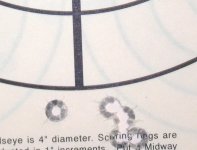You are a little off base, it is all about prefrence pretty much. First off you have to take two similar bullets to compare so let us look at the Nosler Partitions. The .277 150 grain bullet and .308 180 grain bullet have similar BC and SD. Going to Federal's web site you can compare ballistics of the loaded ammunition.
Why would you compare similar bullets? You want to compare the best bullet for each option.
For starters, ignore drop numbers, for a long range target gun they are meaningless. If you know the target is 1000 yards away, as long as you know the drop and your sights can get you on paper, it doesn't matter if the drop is 100", 300", or 400". All that matters is wind.
If you are shooting long range, you aren't using factory ammo, and if you are shooting 30-06 you aren't shooting 180gr bullets. You are shooting match bullets, over 200 grains.
A .308 220gr SMK @ 2500 FPS drifts 17.1" @ 500 yards in a 10 MPH full value wind.
A .308 200gr SMK @ 2600 FPS drifts 18.2" @ 500 yards in a 10 MPH full value wind.
A .308 210gr Berger VLD @ 2500 FPS drifts 16.8" @ 500 yards in a 10 MPH full value wind.
On paper the .270 is about the same, depending on bullet.
A .277 150 gr Berger VLD @ 2900 FPS drifts 16.1 @ 500 in a 10 MPH full value wind.
A .277 135gr SMK @ 3000 FPS drifts 17.7" @ 500 yards in a 10 MPH full value wind.
From what I can see, Berger makes the only decent heavy match bullets in .277, Sierra only goes up to 135 gr, which is still pretty good. I don't see any other match quality bullets in .277.
With the .308 you can get good match bullets from just about everyone, and they are about $10/box cheaper than the the heavy Bergers.
For comparison, the 6.5-06 or 6.5-284:
.264 140gr AMAX @ 2950 drifts 15.6" @ 500 yards in a 10 MPH full value wind.
.264 142gr SMK @ 2950 drifts 14.6" @ 500 yards in a 10 MPH full value wind.
.264 139gr Scenar @ 2950 drifts 14.7" @ 500 yards in a 10 MPH full value wind.
.264 140gr Berger VLD @ 2950 drifts 13.4" @ 500 yards in a 10 MPH full value wind.
And while not as available as .308, there are a lot of choices in quality match bullets, and the worst of the 6.5mm ~140gr bullets is better than the best 270 or 30-06, with equal or less recoil.
6.5-284 works better with the 6.5 bullets and you can buy properly headstamped brass. With the long action you can use the longest 6.5 bullets in the magazine without fear of eating powder capacity.
For what it's worth, my Hornady manual shows 2-300 FPS higher for the 6.5-06 over the 6.5-284 with the same weight bullet. For the Hodgdon load data they are about equal. As to the headstamp, I really don't care, and .25-06 brass is about half the price of 6.5-284 brass.
That being said, in some cases you get what you pay for, and Lapua brass is the best I have ever seen. They make 6.5-284 brass, but the only option for them for the 6.5-06 is to start with 30-06, and that needs more prep than just a neck size.


